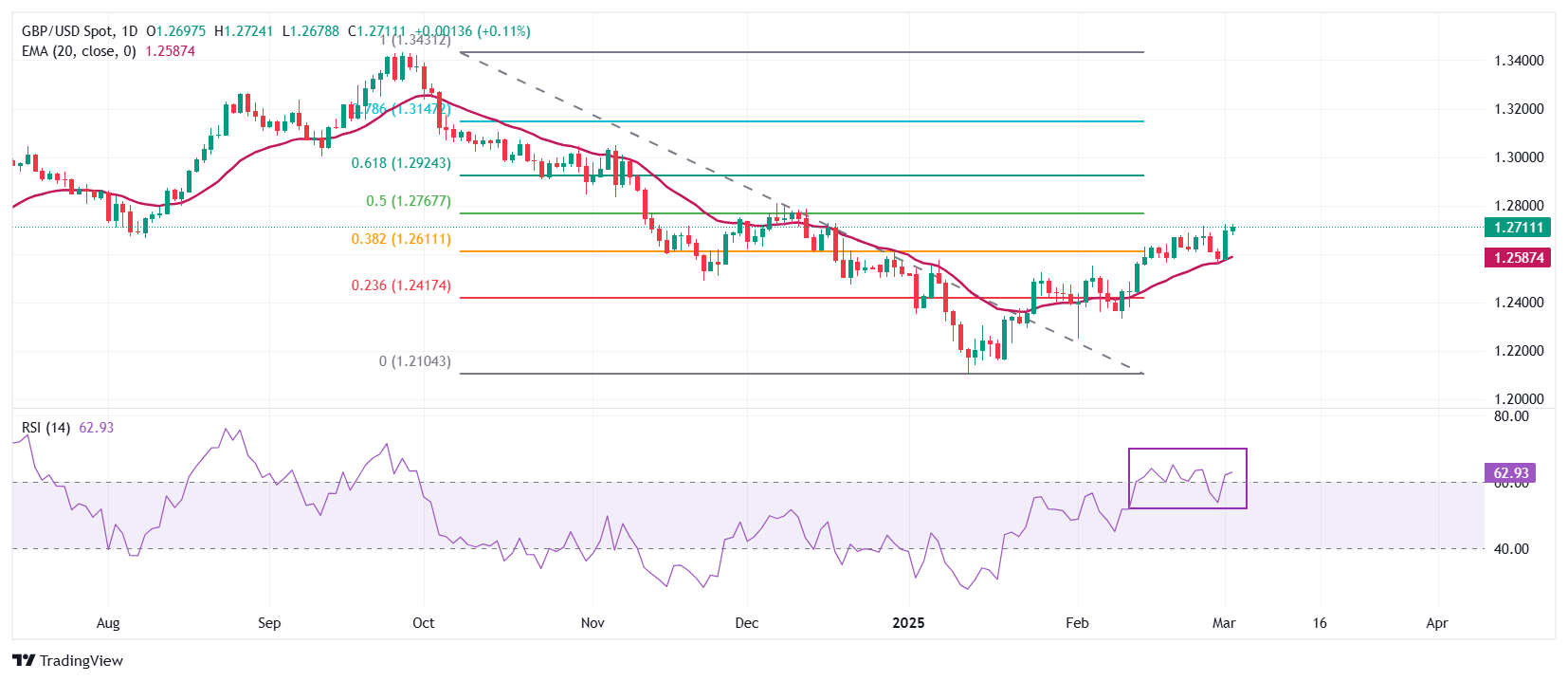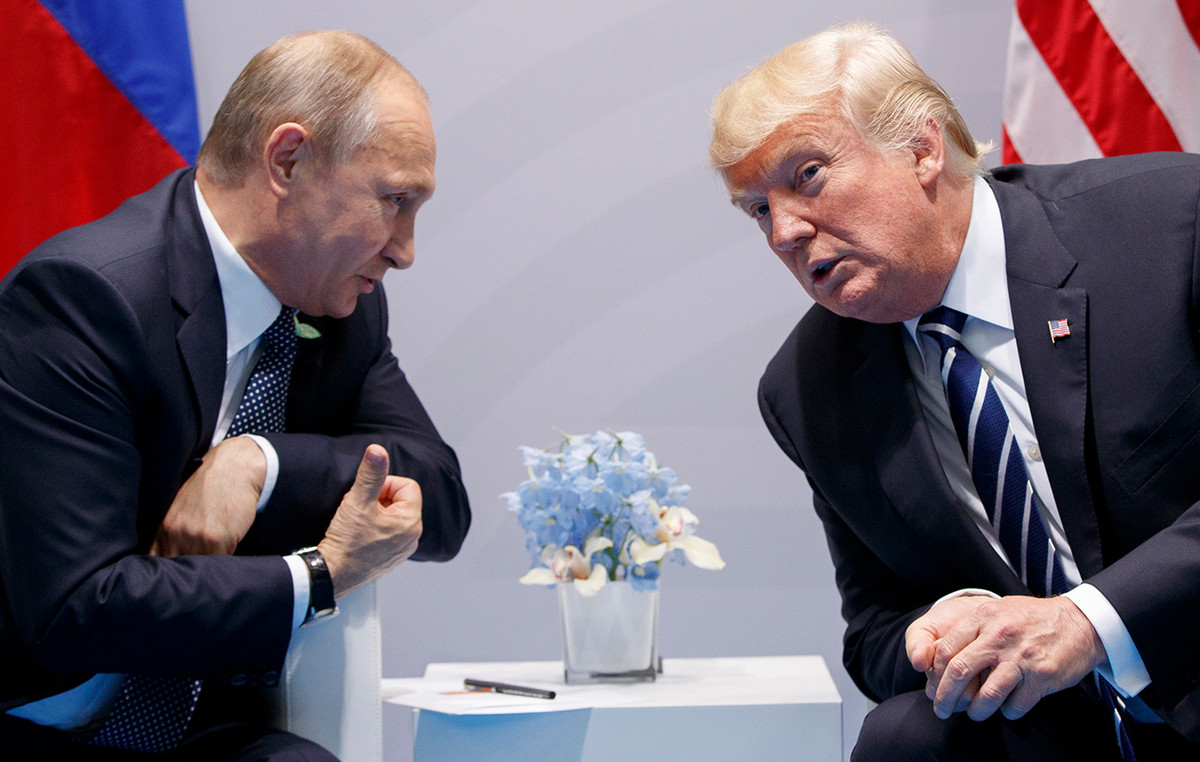- The pound sterling clings to profits about 1,2700 against the US dollar, since the operators have increased moderate bets on the Fed for the June meeting.
- The president of the USA, Donald Trump, has imposed 25% tariffs on Canada and Mexico and an additional 10% to China.
- The BOE is expected to follow a gradual cycle of politics relaxation, since inflation in the United Kingdom is expected to remain high.
The sterling pound (GBP) remains firm about 1,2700 against the US dollar (USD) in the European session on Tuesday. The GBP/USD retains Monday’s profits while the US dollar extends its fall in the middle of an increase in moderate bets on the Federal Reserve (Fed). The dollar index (DXY), which tracks the value of the dollar against six main currencies, slides about 106.30.
The operators have increased the bets that support the Fed to resume the relaxation cycle of the policy at the June meeting, which was paused in January. The probability that the Central Bank reduces interest rates in June has increased to 86.9% from 69% registered a week ago, according to the CME Fedwatch tool.
An expected deceleration in the Personal Consumption Expenditure Index (PCE) US for January, a strong fall in consumer confidence for February – the first fall in January personal spending data in two years – and weak data of the ISM manufacturing PMI for February have contributed to market expectations that the Fed could resume the monetary expansion cycle in June.
Looking ahead, investors will focus on the change of employment of US ADP, the US ISM services PMI and US non -agricultural payroll data (NFP) for February. All of them will be published during this week and they are likely to influence market expectations about the perspective of the Fed monetary policy.
What moves the market today: the sterling pound will be influenced by the development of the peace plan in Ukraine
- The sterling pound exhibits mixed performance worldwide, with investors looking for more developments in the Ukraine peace plan. During the weekend, paneuropean leaders, including Ukrainian President Volodimir Zelenski, agreed to structure a draft to end the three -year war in Ukraine at a high -risk summit in London.
- In a broader sense, the perspective of the British currency remains firm, since investors expect the Bank of England (BOE) to follow a gradual approach to monetary expansion. These expectations have been reinforced by high salary growth in the United Kingdom, which could maintain persistently high inflationary pressures.
- In addition, the executive director of the British Retail Consortium (BRC), Helen Dickinson, has projected that inflation could increase even more, since retailers face an increase of 7 billion pounds (8.88 billion dollars) in annual costs this year due to an increase of almost 7% in the minimum wage, taxes on packaging and an increase in taxes on payroll announced in the payroll Chancellor of the United Kingdom, Rachel Reeves, reports Reuters.
- At the global level, the tariff agenda of US President Donald Trump is expected to keep investors on alert. 25% tariffs to Canada and Mexico and an additional 10% to China have entered into force on Tuesday, noting that the fears of a global commercial war have become real. In retaliation, China has also imposed tariffs on important agricultural imports.
Technical Analysis: The sterling pound is strengthened about 1,2700
The sterling pound demonstrates strength about 1,2700 against the US dollar on Tuesday. The GBP/USD pair was strongly recovered on Monday after a 20 -day exponential mobile (EMA) average reversion movement about 1,2580.
The 14 -day relative force (RSI) index rises above 60.00. A new bullish impulse will take action if the RSI remains above that level.
Looking down, the minimum of February 11, 1,2333 will act as a key support zone for the torque. Upwards, the 61% fibonacci recoil level in 1,2924 will act as a key resistance zone.
LIBRA ESTERLINA FAQS
The sterling pound (GBP) is the oldest currency in the world (886 AD) and the official currency of the United Kingdom. It is the fourth most commercialized currency exchange unit (FX) in the world, representing 12% of all transactions, with an average of $ 630 billion a day, according to data from 2022. Its key commercial peers are GBP/USD, which represents 11% of FX, GBP/JPY (3%) and EUR/GBP (2%). The sterling pound is issued by the Bank of England (BOE).
The most important factor that influences the value of sterling pound is the monetary policy decided by the Bank of England. The Bank of England bases its decisions itself has achieved its main objective of “price stability”: a constant inflation rate of around 2%. Its main tool to achieve this is the adjustment of interest rates. When inflation is too high, the Bank of England will try to control it by raising interest rates, which makes access to credit for people and companies more expensive. This is generally positive for sterling pound, since higher interest rates make the United Kingdom a more attractive place for global investors to invest their money. When inflation falls too much it is a sign that economic growth is slowing down. In this scenario, the Bank of England will consider lowering interest rates to reduce credit, so that companies will borrow more to invest in projects that generate growth.
Published data measure the health of the economy and can affect the value of sterling pound. Indicators such as GDP, manufacturing and services PMI and employment can influence the direction of the sterling pound.
Another important fact that is published and affects the pound sterling is the commercial balance. This indicator measures the difference between what a country earns with its exports and what you spend on imports during a given period. If a country produces highly demanded export products, its currency will benefit exclusively from the additional demand created by foreign buyers seeking to buy those goods. Therefore, a positive net trade balance strengthens a currency and vice versa in the case of a negative balance
Source: Fx Street
I am Joshua Winder, a senior-level journalist and editor at World Stock Market. I specialize in covering news related to the stock market and economic trends. With more than 8 years of experience in this field, I have become an expert in financial reporting.








